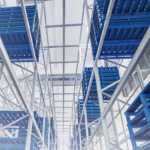Australia is rapidly adopting automation across various industries. Automation solutions provide numerous benefits, like improved efficiency, quality, and safety. However, the rise of automation also raises concerns about potential job losses. This article explores the current state of automation in Australia and its future outlook.
What is Automation?
Automation refers to using technology to perform tasks previously done by humans. It involves the integration of hardware, software, sensors, and network connectivity to monitor and control different processes and machines. The level of automation ranges from basic to advanced.
Basic automation replaces human effort but requires human intervention for decision-making. Advanced automation mimics human skills like observation, judgement, planning, and learning. It can function independently under dynamic real-world conditions. Artificial Intelligence (AI) powers cutting-edge automation solutions.
Automation Trends in Australia
Australia has seen significant growth in automation adoption over the last decade. A recent report by the Committee for Economic Development of Australia (CEDA) indicates that over the past 15 years, the incomes of lower-skilled Australian workers have stagnated as routine tasks get automated.
Various factors drive automation in Australia, including:
- Labor costs: Australia has relatively high labor costs compared to other Asia-Pacific countries. Automating tasks performed by low-skilled workers can reduce salary expenses.
- Skills gap: low-skilled manual jobs remain unfilled in many industries. Automation provides a viable alternative.
- Competitiveness: Adopting automation helps Australian companies stay globally competitive through improved productivity and efficiency.
- Workplace safety: Automating high-risk activities in domains like mining improves worker safety.
Some of the leading industries using automation in Australia include:
- Manufacturing: Robotics and other technologies automate production processes. Australian manufacturers extensively use automation to enhance quality, output, and precision.
- Warehousing and logistics: Automated warehouses and delivery drones streamline supply chain operations. Amazon opened its first robotic warehouse in Australia in 2017.
- Mining: Autonomous trucks, drills, and trains help extract resources more efficiently. Rio Tinto operates the world’s largest autonomous mining operation in Pilbara, Western Australia.
- Agriculture: Smart farming equipment like driverless tractors and fruit picking robots help automate tedious and labor-intensive tasks. The Australian Centre for Field Robotics is a global leader in developing agricultural robotics.
- Financial services: AI-based fraud detection, automated loan approvals, robo-advisors, and chatbots improve the customer experience and efficiency. Australia’s big four banks increasingly rely on automation.
RELATED: The Impact of Logistics Automation on Australia.
The Future of Work
The rise of automation raises concerns about humans being replaced by machines. According to McKinsey, more Australian jobs could be automated by 2030.
However, new jobs will also emerge from automation. AI and robotics create roles related to deploying, monitoring, and servicing automated systems. Developing automation solutions themselves requires high-skilled jobs like robotics engineers, data scientists, and machine learning experts.
Moreover, automation augments human capabilities rather than replacing jobs entirely. It takes over tedious and dangerous work, enabling humans to focus on creative and meaningful aspects. Proper policies and retraining programs can smoothen the transition for displaced workers.
Australia can gain immensely from automation but needs to judiciously shape its evolution. Education and training must prepare workers for future tech-enabled jobs. Fostering human-machine collaboration is key; automation stands in for humans where suitable, and vice versa. With prudent policies and strategies, Australia can harness automation to drive inclusive growth and prosperity.
Frequently Asked Questions
- What industries see the most automation adoption in Australia?
The manufacturing, warehousing, mining, agriculture, and financial services sectors lead in the use of automation in Australia. Advanced robotics, driverless vehicles, AI fraud detection, and other technologies drive efficiency and productivity gains. - Which Australian companies offer automation solutions?
Some of the top players offering industrial automation solutions in Australia include Yokogawa, Siemens, Rockwell Automation, Honeywell, Emerson, and Mitsubishi Electric. Local providers like Ampcontrol and Red Dog Systems also serve the automation needs of Australian firms. - What role does the Australian government play in automation?
The Australian government recognises both the opportunities and challenges of automation. It aims to support businesses in adoption while transitioning and upskilling workers through policy initiatives like the Future Skills Framework. The government also funds research into emerging technologies via bodies like CSIRO. - How does Australia compare to other countries in terms of automation adoption?
Australia lags countries like South Korea, Japan, and Germany in automation but fares better than many other nations. With a robot density of around 200 robots per 10,000 employees, Australia needs greater adoption to boost international competitiveness. - What are the risks associated with increased automation?
Over-automation without retraining workers can lead to structural unemployment in impacted industries. It risks increasing inequality and divisions in society. Thoughtfully managing the pace and scope of automation and having supportive policies for displaced workers are crucial.
Discover the future of Warehouse Automation with SmartlogitecX, brought to you by the technological prowess of WayZim Technologies. We’re leading a logistics revolution in Australia and New Zealand. Choose SmartlogitecX for a blend of local insight and global innovation. Transform your warehouse operations with our specialised technology. Interested in advancing your logistics? Contact our SmartlogitecX sales team for a solution tailored to your needs.



